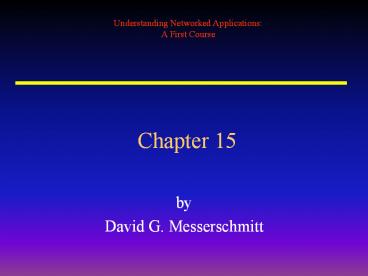David G. Messerschmitt - PowerPoint PPT Presentation
Title:
David G. Messerschmitt
Description:
Each operation results in a new table, so they can be concatenated ... H3 Roger A. Strauch Professor of A HREF='http://www.eecs.berkeley.edu/' Electrical ... – PowerPoint PPT presentation
Number of Views:27
Avg rating:3.0/5.0
Title: David G. Messerschmitt
1
Chapter 15
- by
- David G. Messerschmitt
2
Databases
- by
- David G. Messerschmitt
3
Databases
- Treat data as a separate asset
- May be shared by multiple applications
- Provide protection and integrity features
appropriate to mission-critical data - Access control
- Integrity constraints
- Persistence
- etc.
4
Two capabilities
Application I
Application II
Sharing two or more applications accessing the
same databases
Aggregation accessing multiple databases
Databases
5
Relational table
Table
Employee
Name
Address
Dept
Record
Field
6
Database operations
Employees
Departments
Each operation results in a new table, so they
can be concatenated
PROJECT
SELECT
7
Multiple tables
PROJECT
SELECT
8
Record at a time processing
Database
Application logic (system programming language)
SQL
9
SQL interface
- Presents single abstract interface to the
application logic - Standardized, not vendor specific
- Stored procedures and extensions violate this
- Encapsulates various internal details
- Data partitioning and replication
- Host mapping
- File representation
- etc.
10
Fields, columns, attributes
- Entries are simple data types or compositions of
those types - Integrity constraints
Records, rows
11
Object/table correspondence
Class
Class implementation
Employee
Name
Address
Dept
Record-at-a-time program
Object instance data
Attribute
12
Object attributes
- Rows can be considered object instances with the
same attributes - Restriction to simple data types
- No encapsulated state
- No methods
Object instances
13
Object-relational database
- A column can store object instances of a given
class rather than data of a given simple or
compound data type - Because of the table structure, SQL can be
extended to this case - Standard SQL queries can be extended to methods
returning simple data types - Many other good ideas
14
Benefits of ORDBMS
- Extension manage arbitrarily complex data types
- Migration preserve and extend existing databases
- Preserve SQL interface
- OR extensions in latest standard
- All the benefits/experience of earlier databases
- Access control, data integrity, persistence, etc.
- Killer app Behind Web/CGI
- Images, video, audio, animation, applets, etc.
15
Markup languages
- by
- David G. Messerschmitt
16
Definition
- A markup language describes the structure of a
document - Based on tags
- Tags denote structural elements like sections,
subsections, figures, etc - Internationally standardized, so application
independent
17
Example HTML
- HEADgt
- ltMETA NAME"GENERATOR" CONTENT"Adobe PageMill
2.0 Win"gt - ltTITLEgtDavid G. Messerschmitt Homepagelt/TITLEgt
- lt/HEADgt
- ltBODY ALINK"c4124e" BACKGROUND"Images/backgroun
d.jpg"gt - ltH3gtnbsplt/H3gt
- ltBLOCKQUOTEgt
- ltH2gtltTABLE BORDER"5" CELLSPACING"2"
CELLPADDING"0"gt - ltTRgt
- ltTHgt ltP ALIGNLEFTgtltIMG SRC"Images/Messer.gif"
WIDTH"112" HEIGHT"168" ALIGN - "BOTTOM" NATURALSIZEFLAG"3"gtlt/THgtlt/TRgt
- lt/TABLEgt
- lt/H2gt
- ltH2gtltBRgt
- David G Messerschmittlt/H2gt
- ltH3gtRoger A. Strauch Professor of ltA
HREF"http//www.eecs.berkeley.edu/"gtElectrical - Engineering and Computer Scienceslt/Agtlt/H3gt
18
Family lineage
SGML
XML
HTML
Emphasizes formatting and presentation
of documents
Emphasizes structure of documents
Purpose- and industry-specific extensions
19
Data sharing among applications
- Options include
- Messages with defined formats
- Documents (eg. XML)
- Shared databases
- Remote method invocation middleware
- The first two are the most practical for
inter-enterprise applications































